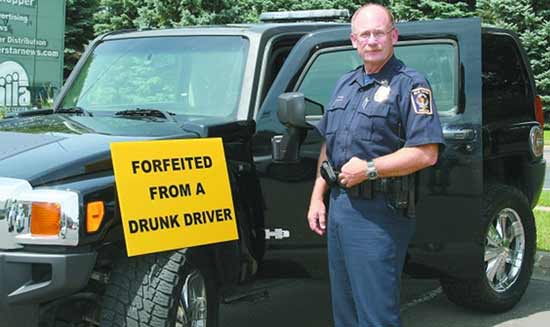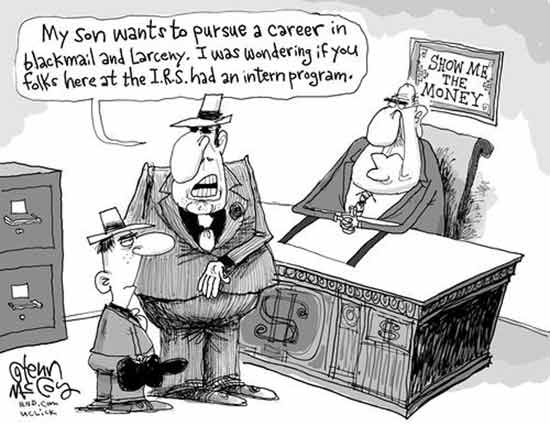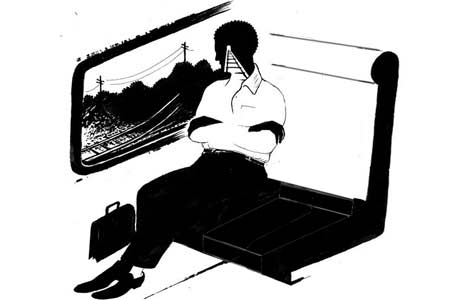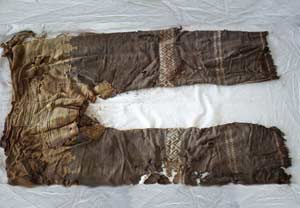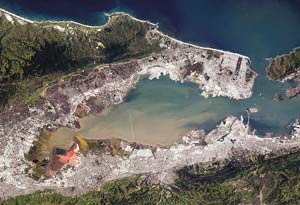A conflict of interest between effective crime control and creative fiscal management will persist
so long as law enforcement agencies remain dependent on civil asset forfeiture.
Forfeiting Justice
Jan. 15, 2015
Time to Prune?
Civil asset forfeiture is a legal procedure useful in certain countries and in certain circumstances. It’s a modern crime control instrument that targets property linked to criminal activity. In the US, at both the state and federal level, it is increasingly being used where it’s inappropriate and for the wrong reasons. People who are unjustly deprived of property need to be guaranteed basic rights, to be informed of their options, and to have their costs of redress minimised. Other countries should take care to avoid the mistakes made in the US. Unfortunately, countries in Europe, Asia, Africa, Australia, and the Americas, have enacted asset forfeiture statutes modelled on US law.
What Is Civil Asset Forfeiture in the US?
Asset forfeiture is nothing new — one of the initial tasks completed by the first US Congress was successful passage of forfeiture statutes based on the British Navigation Acts of the mid-17th century (passed during England’s vast expansion as a maritime power). These helped them collect the customs duties that provided 80-90% of their finances. The Acts had required imports and exports from England to be carried on British ships or else the ships (or the cargo on board) could be seized and forfeited to the Crown regardless of the owner’s guilt or innocence. Forfeiture power was upheld in the early US Supreme Court because it was considered a necessity at the time. The Supreme Court permitted the expansion of forfeiture powers during the Civil War, but for the next century it remained a relative backwater in American law with one exception: it was used extensively during Prohibition against automobiles and other vehicles transporting illegal liquor.
There are two types of forfeiture actions: criminal and civil. Criminal forfeiture is in personam, meaning it’s against the person; upon conviction, forfeiture can be used against the convicted offender. Civil forfeiture is in rem, meaning it’s against the property. The two actions differ in many ways, including:
(1) the point in the proceeding at which the property may be seized
(2) the burden of proof necessary
(3) the type of property
Property subject to criminal forfeiture is named in the same indictment that charges a person and happens only if that defendant is convicted of the underlying offense AND the property named in the indictment is proven to have been used in, or is the result of, committing the crime.
Civil forfeiture (against an object) is either summary, administrative, or judicial:
- Summary forfeiture is limited to Controlled Substances and to only a narrow category of property.
- Administrative forfeiture can be against most property valued at $500,000 or less — unless it’s money, in which case there’s no limit. If action isn’t contested by a set deadline, legal claim to the property is barred and the seizing agency keeps whatever they took. The forfeiture can be contested by filing a Claim of Ownership in time. This forces the government to terminate administrative forfeiture and commence judicial action.
- Judicial action (involving a hearing) must be used from the start if the property is valued over $500,000 but isn’t cash, or if it’s real property (like a family home or a business) — except if it’s moveable like a car, truck, boat, or motor home — then it can be seized on the spot.
Federal civil forfeiture burden of proof is probable cause (reasonable grounds for belief of guilt). The government must notify the property owner by mail and publish (now online) its intent to seize the property. After seizure, they then must charge the property with violating the law. Then they must prove the property is subject to forfeiture by showing that a fair and impartial mind would be more inclined toward its guilt than not. States can more-or-less make up their own civil forfeiture rules.
Civil forfeiture may not sound so bad. But note that cars and cash can be taken into custody on the spot, and items are permanently forfeited if a Claim of Ownership isn’t filed in a timely matter. Add to that the fact that for state forfeitures, in a large majority of states the agency doing the seizing benefits from the sale of those assets not properly claimed, and the stage is set for abuse. (In “Taken”, an article in the 12 August 2013 issue of the New Yorker, author Sarah Stillman writes: “In Hunt County, Texas, I found officers scoring personal bonuses of up to $26,000 a year, straight from the forfeiture fund. In Titus County, forfeiture pays the assistant district attorney’s entire salary. Farther south, in Johnson County, I came upon a sheriff’s office that had confiscated an out-of-state driver’s cash, in the absence of contraband, in exchange for a handwritten receipt that gave the traveller no information about who had just taken his money, why, or how he might get it back.”)
Modern civil forfeiture use exploded in the early 1980s as the War on Drugs kicked into gear. Until then, the proceeds from forfeitures had gone not to law enforcement agencies responsible for seizures, but to the government’s general fund. Abuse was apparently not a huge problem. However, in 1984, Congress created the Assets Forfeiture Fund, into which the Attorney General was to deposit all net forfeiture proceeds for use by the Department of Justice and other federal law enforcement agencies. Subsequent amendments dramatically expanded what law enforcement could do with these funds, up to and including purchasing vehicles and paying overtime. In short, after the 1984 amendments, federal agencies were able to retain and spend forfeiture proceeds — subject only to very loose restrictions — giving them a direct financial stake in generating these funds. Most states followed with similar laws of their own.
What could possibly go wrong?
Not Exactly a Model System
In 2000, Congress passed the Civil Asset Forfeiture Reform Act (CAFRA), amending various provisions of federal forfeiture law. While CAFRA offered a number of modest reforms, it didn’t change how forfeiture proceeds were being distributed. In 1986, the second year after the Department of Justice’s Assets Forfeiture Fund was created, the Fund took in $93.7 million in proceeds from forfeited assets. By 2008, the Fund topped $1 billion in net assets and these funds were available for use by law enforcement. And this was just at the federal level. By 2012, it had topped $4 billion (though part of that increase was due to Bernard Madoff; 2013 dropped significantly).
Data on civil forfeitures under state law are shockingly sparse, but evidence indicates its use is extensive and growing. Police can seize cars, money, and other kinds of property that they say has some connection to crime. Once your property is seized, the state should (and generally does) send you a notice that the burden is on you to get your property back. If you don’t respond within a specified timeframe and in the proper manner, law enforcement gets to keep what they took. Even if you respond correctly and within the time limit, you may have to wait months, sometimes more than a year, for a hearing. This represents an assault on private property rights because it isn’t necessary for authorities to show that a property owner is guilty of any criminal misconduct. Civil forfeiture seeks an element of surprise — seize the asset before the potential criminal can conceal it! But all too often no charges are ever filed — or indeed were ever intended to be filed. (From the New Yorker article “Taken” cited above: “The Shelby County courthouse, in Center, Texas has ledgers that list the past two years of the county’s legal cases. One case was titled State of Texas vs One Gold Crucifix. The police had confiscated a simple gold cross that a woman wore around her neck after pulling her over for a minor traffic violation. No contraband was reported, no criminal charges were filed, and no traffic ticket was issued. That’s how it went in dozens more cases involving cash, cars, and jewellery. A number of files contained slips of paper that were roadside property waivers, improvised by the district attorney, which threatened criminal charges unless drivers agreed to hand over valuables. Patterns began to emerge. Nearly all the targets had been pulled over for routine traffic stops. Many drove rental cars and came from out of state. None appeared to have been issued tickets. And the targets were disproportionately black or Latino.”)
If the seized property is worth less than a lawyer would charge to help the owner get it back, then maybe the effort isn’t worth it. Or maybe the owner can’t afford to pay anything and doesn’t realise that a lawyer could be appointed by the court. Or maybe a trial would be too expensive because it would be held hundreds of miles away and necessitate time off the job. A lot of money being made from the sale of asset forfeitures is from small stuff and cash seized at routine traffic stops. Sometimes it can be difficult to prove that the $3,000 in your glove box is there because you’re on your way to look at a used car, not because you just sold a rock of crack cocaine. And the burden of proof is indeed on the property owner to prove his/her innocence.
This may sound like a tacky practice for the most part — and apparently it has devolved into being exactly that in some areas. The average “take” of property to be auctioned is just a few hundred dollars, yet forfeitures supply a large part of some state departments’ budgets. The overriding goal for law enforcement officials should be fair and impartial administration of justice. However, civil forfeiture laws (both at the federal level and in 42 of the 50 US states) dangerously shift law enforcement priorities toward pursuit of profit. Such statutory schemes pervert law enforcement’s responsibility to be fair and can spell disaster for property owners caught in law enforcement drift nets. The current structure of civil forfeiture law in many states creates an incentive for police officers to push the limits on what is permissible, knowing that opposition will be tough to mount.
Canada and Ireland are two countries with forfeiture laws similar to the US. In NZ, the standard of proof required is higher. The United Nations Convention against Corruption recommends asset forfeiture even without a criminal conviction in cases where the offender “cannot be prosecuted by reason of death, flight, or absence, or in other appropriate cases.” That’s vague enough to suit almost any country’s purposes.
What Crimes Can Trigger Civil Asset Forfeiture?
The following property is subject to forfeit (in the United States):
- Any property involved in a transaction (or attempt) to launder money or sell stolen goods.
- Any property obtained directly or indirectly from an offense against a foreign nation involving trafficking in nuclear, chemical, biological, or radiological weapons technology or material, or the manufacture, importation, sale, or distribution of a controlled substance punishable within the foreign nation by death or imprisonment for longer than a year and punishable in the US by more than a year in prison.
- Any property derived from proceeds traceable to kickbacks, securities fraud, counterfeiting (domestic or foreign, securities, money, stamps, or bonds), smuggling, embezzlement, medical theft, interacting in any way with unlicensed explosives (or even information about them), fraud of any kind by foreign or domestic bank principals or their insurers, loan application falsehoods, fake legal documents (including identity theft), fake access devices, accessing a computer without authorisation, concealing assets from proper authorities, defrauding a bank, or committing any “specified unlawful activity” (controlled substances, violence, bank fraud, bribery, treaty violations, human trafficking, serious pollution, or biological warfare of any kind). Or conspiring to do any of the above.
- Any violation of a federal programme, fraud and false statements, fraud against the US, concealing assets, or mail or wire fraud, all to do specifically with deceiving financial regulators.
- Ponzi schemes, snake oil sales, and similar scams.
- Removing vehicle identification numbers, being involved with moving stolen vehicles across borders, or armed robbery of a vehicle.
- Any kind of terrorism whatsoever against Americans or their property or against any international organisation or foreign government if any part occurred within US jurisdiction or any kind of related proceeds whatsoever.
- Lawful goods or services provided in an illegal manner.
A huge catch-all paragraph covers:
| destroying aircraft | being violent at an international airport | threatening a Federal official’s family | |||
| false oath-swearing or claims | posing a threat with variola (smallpox) virus | assassinating a congressman or cabinet member | |||
| trading with the enemy | environmental crimes | terrorist attack transcending national boundaries | |||
| stealing from Customs | creating a border tunnel | defrauding the public of money, property, or records | |||
| assassinating the President | torching government property | dishonest financial institute officials of all kinds | |||
| copyright infringement | affecting interstate / international commerce | smuggling airplanes or drug paraphernalia | |||
| theft from mail | affecting interstate communications | conspiracy to kill/kidnap/maim/injure certain foreign property | |||
| equity skimming | unlawful import/export or sale of firearms | food stamp programme benefits fraud over $5,000 | |||
| murder | trafficking counterfeit goods and services | murder of US police, foreign officials or official guests | |||
| hostage-taking | wilfully injuring government property | destroying property in special US jurisdictions” | |||
| robbing a bank or post office | felonious precursors and essential chemicals | producing child pornography for import into the US (oddly specific) | |||
| kidnapping | terrorist attacks abroad against Americans | violence against ocean navigation or maritime fixed platforms | |||
| weapons of mass destruction | false statements when importing | materially supporting or financing terrorists | |||
| aircraft-destroying missiles | radiological dispersal devices | receiving military training from a foreign terrorist organisation | |||
| felony violation of Foreign Agents Registration Act or Foreign Corrupt Practices Act or Atomic Energy Act (having an unapproved nuclear weapon) | |||||
In Mercer County, New Jersey, one prosecutor preaches the “gospel” that forfeiture is not just for drug arrests — cars can be seized in shoplifting and statutory rape cases as well. (Parents of teenagers, beware.)
Profit Sharing
Today, there are more than 400 federal forfeiture statutes relating to a number of federal crimes, and all states have statutory provisions for some form of asset forfeiture. Federal and state agencies seizing assets include the FBI, IRS, ATF, DEA, FDA, customs and border protection, postal inspection, secret service, highway patrols, and local and state police.
Certain states have strict laws that make forfeiture more difficult and less rewarding, so law enforcement in those states takes advantage of the more generous federal forfeiture laws through a programme called Equitable Sharing. The looser federal government rules can help increase a state’s overall take no matter what that state’s legislature may feel is fair. When a police agency hits on a case with forfeiture potential, they simply call up the DEA, ATF, or some other federal law enforcement agency, who assigns an agent to play a cursory role in the investigation. The case is now federal, and is governed by federal law. The feds collect the forfeiture money, skim their cut off the top, then return the rest to the local police agency. As an example, some states have homestead laws that prevent agents seizing the family home. The federal government has no such exclusion and pre-empts state law. So these states turn their cases over to the feds. When the family home has been seized and auctioned, the feds and the state split the profit. As state laws improve for property owners, use of this Equitable Sharing loophole rises — pursuit of profit is a significant motivator. Simply put, when laws make civil forfeiture easier and more profitable, law enforcement engages in more of it.
Equitable Sharing payments to states nearly doubled from 2000 to 2008, from a little more than $200 million to $400 million. A GAO Report says, “Expenditures in support of forfeiture activities such as equitable sharing payments to state and local law enforcement agencies and payments to victims also increased over the same 9-year period, growing from $458 million in 2003 to $1.3 billion in 2011.” This isn’t a significant part of the federal budget. The highest-paid Equitable Sharing state was California, and, at just under $80 million, it isn’t a huge part of California’s budget, either. But this does only count the part that was shared. The federal annual revenue of the Assets Forfeiture Fund was $1.9 billion in forfeited assets in 2011. The report says that the Department of Justice has the authority to use unobligated balances for any authorised purpose. It acknowledges that its sharing percentage [is sometimes] adjusted upward and “guidance does not include information regarding how … these adjustments should be made — some of their rules aren’t written down”. Systems like these draw opportunists.
In any non-judicial civil forfeiture proceeding, the government involved is required to send written notices to interested parties as soon as practicable (in no case more than 60 days after the date of the seizure, except that this date can be extended by the government for various reasons). Illegally owned items need not be returned, but if an owner believes the property was legally owned, a claim for the return of seized items must be filed no later than the deadline set (which will be at least 35 days after the date a letter is mailed), except that if a letter is not received, then a claim may be filed not later than 30 days after the date of publication of notice of the seizure. Today, publication of federal forfeiture notices are on a government internet site, containing a list of pending forfeiture notices for all federal agencies. I had difficulty finding details of where and when to look for notice publications and where and how to make a state Claim of Ownership. The process can be confusing. If your property is seized in Kansas as you drive from New York to Los Angeles and you don’t receive a letter from the Kansas state police, how will you know when they published the notice and in which Kansas newspaper? And will you have to go there in person to pick your seized goods up if you do get them back?
Claims must identify the property, state the claimant’s interest, and be sworn. It doesn’t have to follow a particular form, so people can file directly, but the claim must be filed under oath (notarised) by the claimant personally, not by an attorney or other representative. A form must be made available if the claimant requests one and the instructions must be written in easily understandable language. (That’s the plan, anyway. The form I saw had understandable language. But I wouldn’t exactly have called it easy.)
Not later than 90 days after a claim is filed, the government (federal and state) has to explain the seizure or else return the property. Oh, except a Court can get extensions (several, in fact). Nevertheless, if the government doesn’t respond or else return the property in a timely fashion, then it has to promptly release it with no further action (such as deducting a hefty fine or fee). This sounds all kinds of annoying, but like people sometimes get their property back.
While the burden of proof on the government is to establish that the property is most likely subject to forfeiture and that there’s most likely a substantial connection between the property and some offence (that the owner may or may not be charged with), an “innocent owner” with an interest in the property who makes a Claim of Ownership has the burden of proving innocence — that he/she did not know of the conduct giving rise to forfeiture and upon learning of it, did all that could reasonably be expected under the circumstances to terminate such use. Say your adult son who lives with you sells marijuana to an undercover officer in your back yard. Or say your daughter downloads a movie from Pirate Bay in her room using her computer. If you’re an “innocent owner”, the burden of proof is on you to prove that you didn’t know what was going on under your very nose. That can be difficult. And if the court finds that the “innocent owner” claim is frivolous, it may impose a civil fine equal to 10% of the value of the forfeited property, but in no event less than $250 or greater than $5,000.
Several property owners in New York State whose rental houses were used by a marijuana grow operation were busted in 2011. The owners had used rental agents and had no idea their tenants were using those properties for illegal purposes. The federal government filed a civil seizure case against the parcels. One lawyer was able to get back his client’s house, although the client had to pay $30,000 in forfeiture fees as well as the lawyer’s hefty bill.
In any forfeiture action in which the subject property is cash, monetary instruments in bearer form, funds deposited in an account in a financial institution, or precious metals, it isn’t necessary for the government to identify the specific property involved. Any money found in the same place or account is forfeited.
What Are the Benefits of Civil Asset Forfeiture?
- It helps police departments balance their budgets.
“We all know the way things are right now—budgets are tight,” Steve Westbrook, the executive director of the Sheriffs’ Association of Texas, says. “It’s definitely a valuable asset to law enforcement, for purchasing equipment and getting things you normally wouldn’t be able to get to fight crime.” Many officers contend that their departments would collapse if the practice were too heavily regulated, and that a valuable public-safety measure would be lost. State law sets out how forfeiture money can be used — on occasion, it can even buy drugs: if police want to start a narcotics task force or do an undercover operation, and need $20,000 to buy a kilogram of cocaine, they can’t go to the legislature for that, so civil asset forfeiture money is ideal.
- It helps lawyers.
In March 2007, Camden County, Georgia, USA deputies pulled over a 43-year-old immigrant from Ghana, for speeding on I-95 on his way home from work. After a search, officers found no evidence of illegal activity but confiscated $43,720 in cash. The man said the money was his life savings and that he was afraid to put it into a bank. A canine search found no trace of drugs and a background check yielded no drug arrests. Nevertheless, officers kept the money and told the man to call back in 2 weeks. The man says that he called multiple times, but made no progress. An in-person visit was also unsuccessful — the sheriff was too busy to see him. Finally, he hired a lawyer, who proved the man had earned the money legitimately. The county returned the money, but the lawyer took $12,000 of it.
- Prosecutors benefit.
The National District Attorneys Association has promulgated several policy statements and guidelines regarding asset forfeiture, recommending its use. There is evidence that prosecutorial discretion has been inappropriately influenced by the presence of asset forfeiture options.
In one seminar captured on video, Connelly called them “little goodies”. He then described how officers in his jurisdiction could not wait to seize one man’s “exotic vehicle” outside a local bar. “A guy drives up in a 2008 Mercedes, brand new,” he explained. “Just so beautiful, I mean, the cops were undercover and they were just like, 'Ahhhh.’ And he gets out and he’s just reeking of alcohol. And it’s like, 'Oh, my goodness, we can hardly wait.’” [Reeking of alcohol? And they could smell it from where they were? Of course they could.]
- Current and former justice officials receive financial rewards.
One police chief of a small town in Texas made it clear that the retention of forfeited assets is a very attractive consideration: “Law enforcement has become a business, and where best to hit narcotics organisations other than in the pocketbook — and then to be able to turn around and use those same assets to benefit our department, that’s a win-win situation as far as we’re concerned.” Perhaps the clearest evidence of the importance that law enforcement places on generating revenues through forfeiture is the political pressure the law enforcement lobby exerts to prevent reforms at both the state and federal levels, which has resulted in considerable revisions to reform efforts that are beneficial to law enforcement. “HR 5212 (113th): Civil Asset Forfeiture Reform Act of 2014” was introduced 28 July 2014. It seeks to strengthen personal property rights under the Fifth Amendment and ensure due process of law by reforming civil asset forfeiture laws. It requires that the government notify all owners of forfeited property of the possibility of using a public defender to argue their case. Among other things, the bill would require the federal Department of Justice to ensure that any equitable sharing with local or state agencies from forfeitures do not violate state laws or limitations. This would mean not sharing forfeitures with states that prohibit it and following state guidelines for usage of funds. The bill has been referred to a Subcommittee. (A similar bill in 2013 quietly died there.)
- It can reduce street racing.
In response to a surge in illegal street-racing fatalities on city streets, San Diego enacted the nation’s first anti-street racing forfeiture ordinance providing for forfeiture of vehicles used in illegal speed contests if the driver has any previous Vehicle Code conviction. Research suggests the ordinance did more to reduce the street racing problems than any other law enforcement activities had done in the past.
- It can send a message that crime pays (for law enforcement).
Indiana State Senator Richard Bray (R-Martinsville), a former prosecutor, private practice lawyer, and chairman of the Senate’s Judiciary Committee, introduced a bill allowing prosecutors to keep 70% of forfeiture proceeds, which they would divide with police departments. The remaining 30% would go to the schools (instead of the nearly 100% currently required). Bray’s bill would change Indiana’s forfeiture law from one of the country’s best (on paper, at least) to one of its worst — but he says his bill would serve 3 goals: “First, we want to send the message that crime doesn’t pay. Second, we want to alleviate the costs of prosecution and law enforcement. Third, we want to enhance Hoosier communities by giving back to our schools.” Giving back less?) Notice what’s missing: no mention of protecting the rights of property owners and no concern for the widely-reported abuses in his state.
What Are the Problems?
In Douglasville, Georgia, USA, population 32,000, an armoured personnel carrier costing $227,000 was bought using money taken from Americans under civil forfeiture laws.
Asset forfeiture practices often go hand-in-hand with racial profiling and disproportionately impact low-income African-American or Hispanic people who the police decide look suspicious and for whom the arcane process of trying to get one’s property back is an expensive challenge.
Behind the rise in seizures is a little-known cottage industry of private police-training firms that teach the techniques of “highway interdiction” to departments across the country. One of those firms created a private intelligence network known as Black Asphalt Electronic Networking & Notification System that enables police nationwide to share detailed reports about American motorists — criminals and the innocent alike — including their social security numbers, addresses, and identifying tattoos, as well as hunches about which drivers to stop. Many of the reports have been funnelled to federal agencies as part of the government’s burgeoning law enforcement intelligence systems — despite warnings from state and federal authorities that the information could violate privacy and constitutional protections. A thriving subculture of road officers on the network now compete to see who can seize the most cash and contraband, describing their exploits in the network’s chat rooms and sharing “trophy shots” of money and drugs. Some police advocate highway interdiction as a way of raising revenue for cash-strapped municipalities. (Commonly, “speed traps” get the cars to stop so that the officer can peer into the car for anything worth seizing, often foregoing a ticket if the driver hands over the booty willingly.)
But it isn’t just drivers passing through:
- A Michigan supermarket owner’s insurance policy specifically stated that no more than $10,000 in cash was covered. So whenever the store’s cash-on-hand approached that amount, the owner sent his daughter to the bank to make a deposit. He’d done this for over 30 years. Federal law requires banks to report cash deposits greater than $10,000, so the tax office used civil forfeiture to seize the owner’s bank account, claiming by making small deposits, he was evading that requirement. Agents said they believed he may be selling more than groceries and seized US$35,651.11. After a lawsuit was filed on the owner’s behalf, the IRS backed down and returned the money.
- A restaurant owner in northwest Iowa operated her establishment for 38 years. A few months ago, two US tax agents informed her they had closed her business bank account and seized all her money — almost US$33,000. The restaurant only accepts cash, which means she makes frequent trips to the bank to avoid holding large sums of money and risking robbery or burglary. The 67-year-old said she received no warning from either her bank or the government before her money was taken. She is still fighting to get it back more than a year later.
Only 1 in 5 IRS seizures is ever prosecuted. But the return rate is somewhat less than 4 in 5.)
Civil forfeiture can raise various legal and policy issues — from property rights to due process. The American state of Illinois, for example, allows the a wait of as long as 6 months before having to prove the legitimacy of the seizure, which proceeding may then be delayed indefinitely for “good cause.” But these forfeited items aren’t evidence. Speeding the process of sorting out which items should be returned and which need to be held sounds like it should be desirable. When cars or money are seized without a warrant for months or years without any judicial hearing, this violates due process rights. One Philadelphia couple were evicted from their home when their son sold $40 worth of illegal drugs to an undercover policeman outside the home but on the property. The parents said they knew nothing of their son’s drug use and they had never benefitted financially from it in any way. But challenging the seizure took months, multiple court visits, and much money to resolve.
In states where agencies get to keep the lion’s share of forfeiture proceeds, drug arrests — which often have the potential of a related civil forfeiture — constitute a significantly higher percentage of all arrests. Many states don’t even require law enforcement agencies to report how much money has been raised and on what items the money has been spent. This guarantees abuse. States that place seized funds in a neutral account, like Maine, Missouri (where proceeds go to a public education fund), North Dakota, and Vermont, have generally avoided major forfeiture-abuse scandals.
Federal and state officials now have the power to seize your business, home, bank account, records, and personal property, all without indictment, hearing or trial.
Everything you have can be taken away at the whim of one or two federal or state officials operating in secret.
We are all potential victims.
— Henry Hyde, Congressman from Illinois
What Can Be Done to Fix Things?
In 2000, the Special Litigation Unit of The Legal Aid Society brought a class action lawsuit on behalf of a number of vehicle owners in New York City (NYC) who had been waiting years for the return of their vehicles. One of those vehicle owners, a named plaintiff on behalf of the lawsuit’s certified class, was Valerie Krimstock. Her name became part of the title of that lawsuit, Krimstock v Kelly — hence the name “Krimstock hearings.” In 2002, the Second Circuit majority opinion was written by Sonia Sotomayor (who went on to become a US Supreme Court Justice). She wrote that under the Due Process Clause of the 14th Amendment, vehicle owners have a right “to ask what 'justification’ the NYC Police Department (NYPD) has for retention of their vehicles during the pendency of proceedings, and to put that question to the NYPD at an early point after seizure in order to minimise any arbitrary or mistaken encroachment upon plaintiffs’ use and possession of their property.”
At the hearing, the NYPD must demonstrate:
1. that it followed proper procedure in arresting the person and taking the vehicle (if they claim contraband was found, they must show that there was probable cause to search the vehicle),
2. that it is likely to win the civil forfeiture action (that the vehicle was used as an instrumental of a crime), and
3. that returning the vehicle would cause a danger to the public.
If the NYPD fails to demonstrate even one of these 3 things, the vehicle is returned to the owner until the outcome of the civil forfeiture action is known. The Second Circuit reasoned that keeping the vehicles so long significantly affected owners since vehicles are “often central to a person’s livelihood or daily activities.” Judges felt many owners were being wronged because the NYPD had a pecuniary interest and because no compensation was being paid for depreciation and replacement costs. The government could generally just have the owners put up a bond instead.
The Krimstock hearings are remarkable because they’re a recent example of an entirely new, judicially created, procedural due process right. The hearings are conducted by the NYC Office of Administrative Trials and Hearings and presided over by administrative law judges. The following year, the Court of Appeals mandated similar hearings be conducted on nearby Long Island.
The absence of Krimstock-like hearings under Illinois’ forfeiture statute was challenged in the US Supreme Court. But upon learning that seized property had been returned in the interim, the Supreme Court said there was no longer a case to rule on and declined to formulate a national policy on when such hearings would be required by due process. It may be some time before the issue makes it that far again. The audio of their oral argument indicates that some Justices felt that at least a degree of prompt process was due (some states already require that), but several others wanted to avoid the due process question until another day.
- At a recent public hearing, the attorney general for the District of Columbia (where the US’s capital is located) acknowledged “very real problems” relating to due-process rights but warned that millions of dollars raised by forfeiture “could very easily be lost” and “an unreasonable burden” placed on his office if reforms supported by the Public Defender Service were enacted.
- The US state of Illinois authorises the government to seize property for over 6 months at a time, without giving the owner any opportunity to contest the seizure whatsoever. The 187-day time limit applies to any personal property worth less than $20,000, which includes most cars. And even after an asset forfeiture action is filed, many more months might pass before a court actually hears the case.
- “What was once a crime fighting and law enforcement tool has since become a profit-making, personal account for some law enforcement officials. Instances of abuse in both the confiscation and spending of asset forfeiture proceeds have increased at alarming rates.” — Texas Senate Committee on Criminal Justice
Many of the people whose cars are seized are poor or minorities. They often lack the means necessary to persuade police to release their property without judicial intervention. Yet it is the private citizen who must persuade to achieve his ends, while government officials can employ force. It is a constant threat that those in positions of power will use that force to serve their own self-interest at the expense of the broader populace. This concern reaches its zenith when government officials stand to aggrandize themselves by seizing individuals’ private property for their own benefit.
Conclusion
Short of abolishing civil forfeiture entirely, governments at the very least should:
- End the direct profit incentive under current civil forfeiture laws. Civil forfeiture revenue should be placed into a neutral fund, such as one for education, drug treatment, or caring for the indigent. This will set a good example for states and for other countries.
- Impose a high standard of proof on law enforcement in civil forfeiture proceedings, requiring that the case be proven by clear and convincing evidence.
- Provide a meaningful defence for “innocent owners” by removing the burden on property owners to prove innocence, instead placing the burden of proof on the government.
- Require all agencies to track and report civil forfeiture revenue and distributions and make that information readily available to the public.
- Respect federalism principles by abolishing Equitable Sharing arrangements. If a state has decided to end the practice of policing for profit, officials in that state should not be allowed to do an end-run around the law by teaming up with the federal government to forfeit property.
UPDATE: On 16 January 2015, US Attorney General Eric Holder issued an order setting forth a new policy prohibiting federal agency forfeiture of assets seized by state and local law enforcement agencies (with a limited public safety exception). Furthermore, the US Department of the Treasury, which has its own forfeiture programme, is issuing a policy consistent with the Attorney General’s order applying to all participants of the Treasury forfeiture programme.
This applies only to Equitable Sharing, but is definitely a step in the right direction.
Sources
“18 US Code § 981 — Civil forfeiture” from the Legal Information Institute, Cornell University Law School, accessed 3 January 2015, http://www.law.cornell.edu/uscode/text/18/981.
“Asset Forfeiture” from White Collar Crime, Federal Bureau of Investigation, accessed 3 January 2015, http://www.fbi.gov/about-us/investigate/white_collar/asset-forfeiture.
“Asset Forfeiture” from Wikipedia, accessed 3 January 2015, http://en.wikipedia.org/wiki/Asset_forfeiture.
“Audit of the Assets Forfeiture Fund and Seized Asset Deposit Fund Annual Financial Statements Fiscal Year 2013” by the US Department of Justice, Office of the Inspector General, Audit Division, Audit Report 14-08, February 2014, http://www.justice.gov/oig/reports/2014/a1408.pdf.
“Civil Asset Forfeiture” from the American Civil Liberties Union, accessed 3 January 2015, https://www.aclu.org/criminal-law-reform/civil-asset-forfeiture.
“Civil forfeiture in the United States” from Wikipedia, accessed 3 January 2015, http://en.wikipedia.org/wiki/Civil_forfeiture_in_the_United_States.
“Civil Forfeiture (HBO)” from Last Week Tonight with John Oliver, 5 October 2014, https://www.youtube.com/watch?v=3kEpZWGgJks.
“Covering Their Assets” by Bradley Balko, Reason, 29 November 2010, http://reason.com/archives/2010/11/29/covering-their-assets.
“Due Process Case to Be Decided on Procedural Grounds” by Ilya Shapiro, Cato at Liberty, Cato Institute, 15 October 2009, http://www.cato.org/blog/due-process-case-be-decided-procedural-grounds.
“Fighting Crime through Superior Steak” from The Economist, “Democracy in America: American Politics” section, 15 October 2013, http://www.economist.com/blogs/democracyinamerica/2013/10/asset-forfeiture.
“Forfeiture Laws, the War of Drugs, and Alvarez v Smith” by Ilya Somin, Findlaw, 14 October 2009, http://writ.news.findlaw.com/commentary/20091014_somin.html.
“Form of the Claim” from Asset Forfeiture Policy Manual (2008), Chap. 2, Sec. III, accessed 3 January 2015, http://www.justice.gov/criminal/foia/docs/2008policy-manual.pdf.
“Iowa restaurant owner’s fight against the IRS gains national attention” by Pat Curtis, Radio Iowa, 28 October 2014, http://www.radioiowa.com/2014/10/28/spirit-lake-restaurant-owners-fight-against-the-irs-gains-national-attention/.
“Krimstock Hearings” from Wikipedia, accessed 3 January 2015, http://en.wikipedia.org/wiki/Krimstock_hearing.
“My Findlaw Column on Alvarez v Smith – A Key Property Rights Case Argued before the Supreme Court Today” by Ilya Sonin, The Volokh Conspiracy, 14 October 2009, http://volokh.com/2009/10/14/my-findlaw-column-on-alvarez-v-smith/.
“Not So Fast” from The Economist, “Democracy in America: American Politics” section, 12 May 2014, http://www.economist.com/blogs/democracyinamerica/2014/05/asset-forfeiture.
“Orange DA promotes boost in asset forfeiture” by Heather Yakin, Times Herald-Record, 28 July 2014, http://www.recordonline.com/apps/pbcs.dll/article?AID=/20140727/NEWS/407270305/0/SEARCH.
“Police Use Department Wish List When Deciding Which Assets to Seize” by Shaila Dewan, The New York Times, 9 November 2014, http://www.nytimes.com/2014/11/10/us/police-use-department-wish-list-when-deciding-which-assets-to-seize.html.
“Poli₵ing for Profit: The Abuse of Civil Asset Forfeiture” by Marian R Williams, Phd and others, Institute for Justice, March 2010, http://www.ij.org/images/pdf_folder/other_pubs/assetforfeituretoemail.pdf.
“Problems for which Forfeiture Is a Remedy: Street Racing” from the Centre for Problem-Oriented Policing, accessed 3 January 2015, http://www.popcenter.org/responses/asset_forfeiture/7.
“The Seizure of Illicit Assets: Patterns of Civil Forfeiture in Canada and Ireland” by Dr M Michelle Gallant and Dr Colin King, published in Common Law World Review, 2013, http://www.academia.edu/2964277/The_Seizure_of_Illicit_Assets_-_Patterns_of_Civil_Forfeiture_in_Canada_and_Ireland_Gallant_and_King_.
“Stop and Seize” by Michael Sallah, Robert O’Harrow Jr and Steven Rich, The Washington Post, 6 September 2014, http://www.washingtonpost.com/sf/investigative/2014/09/06/stop-and-seize/.
“Taken” by Sarah Stillman, The New Yorker, 12 August 2013, http://www.newyorker.com/magazine/2013/08/12/taken.
“This Federal Program Lets Cops Seize Cash, Evade State Laws and Keep Over A Billion Dollars” by Nick Sibilla of the Institute for Justice, Forbes, 29 September 2014, http://www.forbes.com/sites/instituteforjustice/2014/09/29/highway-cash-seizures-civil-forfeiture/.
“Utah lawmakers quietly roll back asset forfeiture reforms” by Radley Balko, The Washington Post, 8 January 2014, http://www.washingtonpost.com/news/opinions/wp/2014/01/08/utah-lawmakers-quietly-roll-back-asset-forfeiture-reforms/.
The Distillery
The Madding Crowd, Celestial Dog Pack, and Dam Goats
- A beach is a place where sand stops to rest for a moment before resuming its journey to somewhere else. Sand moves from beach to sea bottom and back again, forming shorelines and barrier islands that until recently were able to repair themselves on a regular basis, producing the illusion of permanence. Today, however, 75-90% of the world’s natural sand beaches are disappearing, due partly to rising sea levels and increased storm action, but also to massive erosion caused by the human development of shores. Many low-lying barrier islands are already submerged. Yet the extent of this global crisis is obscured because beach nourishment projects attempt to hold sand in place and repair the damage. Endless lines of dump trucks fill in bare spots and restore dunes. In recent decades, barrier islands on the US east coast have used 23 million loads of sand (either mined inland and trucked or else dredged from coastal waters, creating turbidity that kills coral beds and damages spawning grounds). Damming rivers holds back the flow of sand from mountainous interiors. In the US alone mined sand is a billion-dollar annual business. Huge machines in open pits dig for old glacial sand which is being used up. Desert sand is too fine — it blows away. (Beach sand for Dubai is imported from Australia.) Now Earth is short of beach-quality sand, which is also used for abrasives, glass, plastics, microchips, toothpaste, hydraulic fracturing, and concrete (which takes 80% of all sand mined). Sand is the natural element most in demand around the world (other than water and air), a situation that puts the preservation of beaches in great danger.
- Journalists consider two major factors in choosing to report on an event or not: the importance of the event and the audience’s interest in it. An efficacious means of drawing public attention to important national news stories? Dogs. The national news agendas of 10 regional newspapers in relation to that of The New York Times over a 12-year period indicates that the effect of having a dog involved in a national news event increases the likelihood that that event gets reported in regional newspapers. This dog effect is about equivalent to the effect of whether a story warrants front or back-page national news coverage in The New York Times. Thus, dogs are a seemingly important factor in news decisions. Therefore, I have included a picture of what I will call dog stars in order to increase my readership.
- Goats have been spotted scaling walls in Italy (pictured) and licking the stones for their salts and minerals. Known as mineral licks, this behaviour is similar to that seen among macaws, and the goats use it as a supplement when food supplies are low, or when they’re unwell.
Limitless Sky
- Possibly the core of the jet stream or some obstacle in the air can trigger this (such as several tall tv towers). This slowly swirling motion could perhaps even be caused from the wingtips of a passing jet.
- This is called a hole-punch cloud. The setting sun is causing the rim of the hole to glow, causing it to look more unusual. This was taken in Moscow, Novokosino.
- A sunrise in Gulfport, Mississippi.
- Gulf of Carpentaria in Northern Australia is a magnet for growing numbers of soaring pilots and scientists. Unique in all the world and shrouded in mystery, the Morning Glory arrives regularly each spring. Morning Glory waves sometimes exceed 1,000 kilometres in length and 10,000 feet in height and are associated with the Northern Australian Cloud Line. This photo was taken in 1993.
- On a clear day you can see forever — or at least from Havana to Washington, District of Columbia USA.
- This odd sharp-edged cloud appeared over eastern Massachusetts recently. An isentropic lift (meaning no change in energy) occurs when air rises up and over another air mass following a constant potential temperature surface. If the air is close enough to saturation, the lift over a colder boundary produces cloudiness. A warm frontal boundary was involved here, but it was located well to the south and east of the sharp edge and was the source of warm moisture. Likely there’s a mid-level wind shift at the meeting boundary of the two masses.
Animal, Vegetable, Mineral
- This goliath grouper photographed off Jupiter, Florida looks like it’s wearing an elaborate headdress. Groupers (gropers) can weigh 800 pounds (364 kilograms) and be 9 feet long (2¾ metres). I couldn’t find why baitfish seem to constantly surround grouper. (It is a rather common occurrence.) For protection? Perhaps they’re too small for him to bother eating?
- This is the result of low temperatures and high winds in the Beskydy Mountains, a range that forms the border between Slovakia and the Czech Republic.
- The stunning Danxia Scenic Area is located in northwest China’s Gansu Province. Danxia, which means rosy cloud, is a special landform comprised of reddish sandstone that has been eroded over time into a series of mountains surrounded by curvaceous cliffs and many unusual rock formations.
What Is There to Be Prejudiced About?
- There are 3 important genes coding for skin colour — we get one of each from each of our parents. Call the genes A, B, and C — every human has two A, two B, and two C genes with which to make skin pigmentation. If a gene mutates and become less active, it can’t make as much skin pigment and so that person will get a bit lighter in colour. All 3 of the genes will mutate for some people over time. We will give the mutated gene a lower-case letter instead. Now, there are 6 possible genes for skin colour: A, a, B, b, C, and c. The higher case genes are better at producing skin colour while the lower case genes are worse. Humans have interbred for countless generations. The genes for colour can be inherited in all the combinations shown on the colour chart above (depending on the genes your parents cano contribute). If you live in sunny places, it’s healthier to have darker skin to protect you from the sun. If you live farther from the equator, it’s beneficial to have lighter skin, as you need to absorb more sun when it’s available so that you can make enough vitamin D.
- "The Seat Not Taken" by John Edgar Wideman (professor of Africana studies and literary arts at Brown), 6 October 2010:
Over the last 4 years, excluding summers, I have conducted a casual sociological experiment in which I am both participant and observer. It’s a survey I began not because I had some specific point to prove by gathering data to support it, but because I couldn’t avoid becoming aware of an obvious, disquieting truth. Almost invariably, after I have hustled aboard early and occupied one half of a vacant double seat in the usually crowded quiet car, the empty place next to me will remain empty for the entire trip. I’m a man of colour, one of the few on the train and often the only one in the quiet car, and I’ve concluded that colour explains a lot about my experience. Unless the car is nearly full, colour will determine, even if it doesn’t exactly clarify, why 9 times out of 10 people will shun an open seat if it means sitting beside me. Giving them and myself the benefit of the doubt, I can rule out excessive body odour or bad breath; a hateful, intimidating scowl; hip-hop clothing; or a hideous deformity as possible objections to my person. Considering also the cost of a ticket, the fact that I display no visible indications of religious preference and, finally, the numerous external signs of middle-class membership I share with the majority of the passengers, colour appears to be a sufficient reason for the behaviour I have recorded.
Of course, I’m not registering a complaint about the privilege, conferred upon me by colour, to enjoy the luxury of an extra seat to myself. I relish the opportunity to spread out, savour the privacy and quiet and work or gaze at the scenic New England woods and coast. It’s a particularly appealing perk if I compare the train to air travel or any other mode of transportation (other than walking or bicycling) for negotiating the mercilessly congested Northeast Corridor. Still, in the year 2010, with an African-descended, brown president in the White House and a nation confidently asserting its passage into a post-racial era, it strikes me as odd to ride beside a vacant seat just about every time I embark on a 3-hour journey each way, from home to work and back. I admit I look forward to the moment when other passengers, searching for a good seat, or any seat at all on the busiest days, stop anxiously prowling the quiet-car aisle, the moment when they have all settled elsewhere, including the ones who wilfully blinded themselves to the open seat beside me or were unconvinced of its availability when they passed by. I savour that precise moment when the train sighs and begins to glide away from Penn or Providence Station, and I’m able to say to myself, with relative assurance, that the vacant place beside me is free, free at last, or at least free until the next station. I can relax, prop open my briefcase or rest papers, snacks or my arm in the unoccupied seat. But the very pleasing moment of anticipation casts a shadow, because I can’t accept the bounty of an extra seat without remembering why it’s empty, without wondering if its emptiness isn’t something quite sad. And quite dangerous, also, if left unexamined.
Posters in the train, the station, the subway warn: if you see something, say something.
Three Interesting Things
- eiπ + 1 = 0 is basically an equation about numbers — specifically, those elusive constants π and e. Both are “transcendental” quantities; in decimal form, their digits unspool into infinity. And both are ubiquitous in scientific laws. But they seem to come from different realms: π (3.14159 …) governs the perfect symmetry and closure of the circle; it’s in planetary orbits, the endless up and down of light waves. e (2.71828 …) is the foundation of exponential growth, that accelerating trajectory of escape inherent to compound interest, nuclear fission, Moore’s law. It’s used to model everything that grows. What Euler showed is that π and e are deeply related, but in a very weird way. They’re connected in a dimension perpendicular to the world of real things — a place measured in units of i, the square root of –1, which of course doesn’t exist. Mathematicians call it an imaginary number. On a graph with real numbers on the horizontal axis and imaginary ones on the vertical, using the exponential function, f(x) = ex would ordinarily make an upward swooping curve on the graph. But put i in there, Euler showed, and eix instead traces a circle around the origin — an endless wheel intercepting reality at –1 and +1. Add another axis for time and it’s a helix winding into the future; viewed from the side, the helix is an oscillating sine wave. Now take that function f(x) = eix, set x = π, and you get eiπ = –1. Rearrange terms and you have the famous identity: eiπ + 1 = 0. This combines the 5 most fundamental numbers in math — 0, 1, e, i, and π — in a relation of irreducible simplicity. Immensely useful in the real world, it translates one type of motion into another, letting engineers convert trig problems into more tractable algebra. It’s the secret sauce in Fourier transforms used to digitise music, and it tames all manner of wavy things in quantum mechanics, electronics, and signal processing; without it, computers might not exist.
- The oldest known pants are between 3,000 and 3,300 years old. Uncovered in the Yanghai graveyard in western China’s Tarim Basin along with the remains of two roughly 40-year-old men, they suggest that nomadic herders in Central Asia invented pants to provide bodily protection and freedom of movement for horseback journeys and mounted warfare. Previously, Europeans and Asians wore gowns, robes, tunics, togas or — as observed on the 5,300-year-old body of Ötzi the Iceman — a 3-piece combination of loincloth and individual leggings. Each pair of trousers was sewn together from 3 pieces of brown-coloured wool cloth, one piece for each leg and an insert for the crotch. Finished pants included side slits, strings for fastening at the waist and woven designs on the legs. A dry climate and hot summers helped preserve human corpses, clothing and other organic material in the Tarim Basin. More than 500 tombs have been excavated since the early 1970s.
- In Seoul, South Korea the government has begun to replace old street lights with new LED lamps. The goal is to reduce electricity costs and light pollution. The difference is quite dramatic. Not only are the LED lights more efficient and they reduce light pollution, but they illuminate the road more effectively, making it safer to drive at night.
Mondegreen means a misheard word or phrase that makes sense in your head, but is, in fact, entirely incorrect. The term mondegreen is itself a mondegreen. In November, 1954, Sylvia Wright, an American writer, published a piece in Harper’s where she admitted to a gross childhood mishearing. When she was young, her mother would read to her from the Reliques of Ancient English Poetry, a 1765 book of popular poems and ballads. Her favorite verse began with the lines:
Oh, where hae ye been?
They hae slain the Earl Amurray,
And Lady Mondegreen.
Except they hadn’t.
They took the poor Earl And laid him on the green where he was, alas, all by himself…
On the Streets of China and On the Bottoms of the Unsuspecting
- The 32-year old Tao Liu knows the city of Hefei like his backyard. Since 2005 he’s travelled up, down and across the city in Eastern China on his motorbike reading water meters for a local utilities company. The job was tedious, exhausting and unrewarding, until he picked up a camera. For the past 3 years Liu has used his spare time to capture intimate, witty, and humorous street photos of Hefei. Liu clearly has a knack, not only for being in the right place at the right time, but for a keen eye that spots charming, serendipitous scenes amongst the hustle and bustle of everyday life.
- People often do not use products as designed, sometimes with unfortunate consequences. A woman wore this hoodie during a recent visit to Walt Disney World. The weather had been chilly in the morning, but by afternoon it was quite warm. Rather than carrying it, she had tied the arms of the jacket around her waist, making it look like Mickey had his head in a rather uncomfortable spot. (My thought? This may reflect a Disney clothing designer’s not-so-subtle humour.)
Finding the Right Path
- Forests are dynamic — always growing, renewing, changing. An old-growth forest of hemlock and beech once stretched along northern Pennsylvania, but heavy logging between 1890 and 1930 left only pockets of that early forest. The Forest Service has managed the Allegheny National Forest since 1923; since that time, a vibrant new forest of light-loving hardwoods such as black cherry have flourished, and today the forest boasts some of the world’s finest hardwoods.
- Ragnaie (Spiders Lane), Giardino di Boboli, Florence, Tuscany. Typically, a ragnaia was a carefully-pruned, precisely geometric area of shrubs and ilex. Nets were hung up and 'beaters’ would flush small birds out for the hunters.
- I don’t know where this was taken — I would guess somewhere in the UK — but the photographer seems to have a mastery of lighting should anyone choose to check out his photostream.
Art Takes Many Forms
- Apparently towels are (were?) folded this way at the Hotel Djerba Radisson Blu Palace Resort & Thalasso on Djerba Island off the coast of North Africa. I think I’ll visit there just so I can see one.
- American artist William Bailey often chooses to paint assorted bowls, vases, cups, and other vessels in the style of a classic still-life. However, he does not paint from reality, but rather from memory, transforming a generic object into an object of beauty through close attention to texture, detail, color, and design. Bailey is an emeritus professor of art at Yale University.
- This piece is apparently from the Blitzstein Museum of Art. It is painted by Harry Blitzstein. No other artist has any paintings in the Blitzstein Museum. (That’s one way to get a one-man show.) This artwork was apparently produced in 1994.
- AMC Loews Orpheum 7 – This looks like the one on Third Ave in Manhattan.
- Good composition and lighting but maybe not an original idea.
- For cat owners, the scene is all too familiar: You sit down to finally (finally!) get some work done, and along comes kitty, here to stroll across your keyboard. Now theren is evidence that cats have been up to this same mischief for 6 centuries: inky pawprints grace a page of the 13th volume of Lettere e commissioni di Levante. These collated copies of letters and instructions were sent to merchants and envoys throughout southeastern Europe (Bosnia, Serbia, Croatia) by the Dubrovnik / Ragusan government — sort of a 15th-century Federal Register. The particular document that the cat got its paws on was dated 11 March 1445.
If You Build It They Will Comes
- Singapore. I don’t know what those people on those balconies are finding to be so fascinating.
- Times Square, New York City, 1938. Formerly this was called Longacre Square because the centre of New York’s Carriage Industry was named after Long Acre in London, which was the centre of the carriage trade in Europe), Times Square was renamed in April 1904. It’s one of the world’s most-visited tourist attractions, drawing more than 39 million visitors annually. Approximately 330,000 people pass through Times Square daily.
- Downtown Dallas is enveloped in morning fog. Notice how utterly flat it is.
The Funny Papers
- New Yorker cartoon 22 & 29 December 2014.
- Perhaps that’s a full-sized tree and the person is gigantic? He does seem to have his head in the clouds…
- Still, they’d like to help…
- They keep coming back.
Looking Up, Looking Across, Looking Down
- The Southern Cross, Milky Way and Carina Nebula, viewed from Kenya.
- Capturing an eagle soaring with a camera-mounted drone. This was taken at Denpasar.
- Much of the densely built-up waterfront around San Francisco sits on landfill, often a blend of rubble and sediment dragged up from the bay. In a major earthquake, landfill is more prone to liquefaction than bedrock: it behaves like a liquid, shaking far more severely, and is more likely to give way altogether. Also, the bay looks worse than I ever remember seeing it. Why so much sediment?
On Taking a Sick Day
Some companies require their employees to provide an official medical note when they take a “sick day”. This Canadian doctor’s response is very reasonable. Note that in Canada, the health-care system is publicly funded and all Canadians have access to universal coverage.
 Animals
Animals Animation
Animation Art of Playing Cards
Art of Playing Cards Drugs
Drugs Education
Education Environment
Environment Flying
Flying History
History Humour
Humour Immigration
Immigration Info/Tech
Info/Tech Intellectual/Entertaining
Intellectual/Entertaining Lifestyles
Lifestyles Men
Men Money/Politics/Law
Money/Politics/Law New Jersey
New Jersey Odds and Oddities
Odds and Oddities Older & Under
Older & Under Photography
Photography Prisons
Prisons Relationships
Relationships Science
Science Social/Cultural
Social/Cultural Terrorism
Terrorism Wellington
Wellington Working
Working Zero Return Investment
Zero Return Investment




